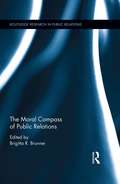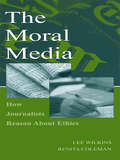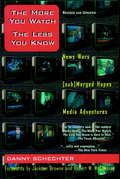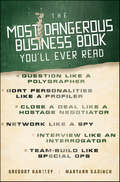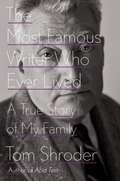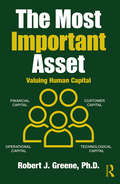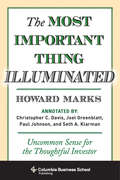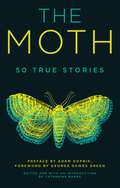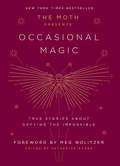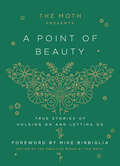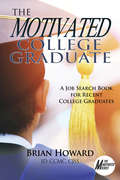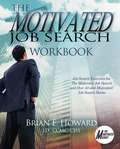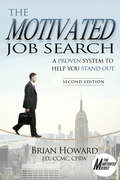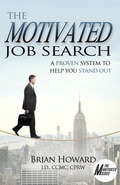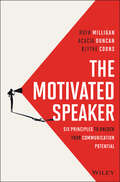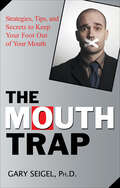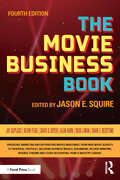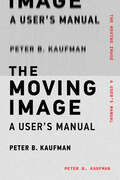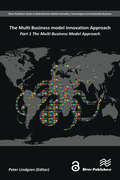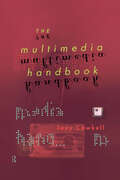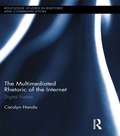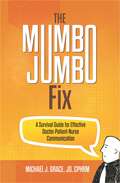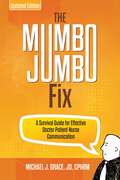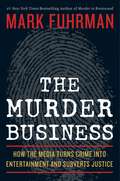- Table View
- List View
The Moral Compass of Public Relations (Routledge Research in Public Relations)
by Brigitta R. BrunnerThe civic and moral responsibilities of public relations are hotly contested topics. While many researchers call for focusing on ethics in public relations, they concentrate on ethics in relation to how people do their jobs. In actuality, emphasis should move beyond professional codes of ethics to include general morality and citizenship. Currently, as the profession receives greater scrutiny, it is important to be aware of the value of public relations in the community. This book centers on four areas of public relations’ conscience in order to examine its role in morality and citizenship: civic professionalism, corporate social responsibility, ethics, and public communication. This approach will help to answer the question of what is public relations’ responsibility to the public good.
The Moral Media: How Journalists Reason About Ethics (Routledge Communication Series)
by Lee Wilkins Renita ColemanThe Moral Media provides readers with preliminary answers to questions about ethical thinking in a professional environment. Representing one of the first publications of journalists' and advertising practitioners' response to the Defining Issues Test (DIT), this book compares thinking about ethics by these two groups with the thinking of other professionals.This text is divided into three parts:*Part I includes chapters that explain the DIT and place it within the larger history of three fields: psychology, philosophy, and mass communication. It also provides both a statistical (quantitative) and narrative (qualitative) analysis of journalists' responses to the DIT.*Part II adds to scholarship theory building in these three disciplines and makes changes in the DIT that adds an element of visual information processing to the test.*Part III explores the larger meaning of this effort overall and links the results to theory and practice in these three fields. The Moral Media pursues connections among various intellectual disciplines, between the academy and the profession of journalism, and among those who believe that what journalists do is essential. As a result, this book is appropriate for aspiring journalists; scholars in journalism and mass communication; psychologists, particularly those interested in human development and behavior; and philosophers.
The More You Watch the Less You Know
by Robert Mcchesney Danny Schechter Jackson BrowneA candid insider's tale of how the media really works and why it doesn't work the way it should, The More You Watch, The Less You Know has emerged as a key catalyst in the debate on media reform. The More You Watch, The Less You Know recounts Schechter's media adventures, from when he was "Danny Schechter the News Dissector" on Boston's WBCN radio, to his stints as a producer at ABC's 20/20 and CNN, to his personal odyssey chronicling the anti-Apartheid revolution in South Africa, to his development of innovative programming like South Africa Now and Rights & Wrongs as an independent producer. In this age of telecommunications bills and media mergers, The More You Watch, The Less You Know is an insider's passionate plea for freedom of the (electronic) press.
The Most Dangerous Business Book You'll Ever Read
by Gregory Hartley Maryann KarinchHone your professional approach to a razor's edge using lessons from military and civilian intelligenceThe Most Dangerous Business Book You'll Ever Read brings expertise from military and civilian intelligence operations into your business life. It lays out hard-hitting interpersonal skills to raise your level of professional effectiveness and vanquish your competition.The Most Dangerous Business Book You'll Ever Read features former Army interrogator Gregory Hartley's unique system of profiling, formula for persuasion, and framework for establishing expertise quickly. Gregory makes his system concrete with case studies, tables, diagrams, and more.Question like a Polygrapher Sort Personalities like a Profiler Close a Deal like a Hostage Negotiator Interview like an Interrogator Network like a Spy Research like an Intelligence Analyst Decide like a SEAL Team-Build like Special Ops Take your career focus to the next level. Discover the skills they don't teach in business school with The Most Dangerous Business Book You'll Ever Read.
The Most Famous Writer Who Ever Lived: A True Story of My Family
by Tom ShroderAn award-winning veteran of The Washington Post and The Miami Herald, Tom Shroder has made a career of investigative journalism and human-interest stories, from those of children who claim to have memories of past lives, in his book Old Souls, to that of a former Marine suffering from debilitating PTSD and his doctor pioneering a successful psychedelic drug treatment in Acid Test. Shroder's most fascinating subject, however, comes from within his own family: his grandfather MacKinlay Kantor was the world-famous author of Andersonville, the seminal novel about the Civil War. As a child, Shroder was in awe of his grandfather's larger-than-life character. Kantor's friends included Ernest Hemingway, Carl Sandburg, Gregory Peck, and James Cagney. He was an early mentor to the novelist John D. MacDonald and is credited with discovering the singer Burl Ives. Kantor wrote the novel Glory for Me, which became the multi-Oscar-winning film The Best Years of Our Lives. He ghostwrote General Curtis LeMay's memoirs, penning the infamous words "We're going to bomb them back into the Stone Age," referring to North Vietnam. Kantor also suffered from alcoholism, an outsize ego, and an abusive and publicly embarrassing personality where his family was concerned; he blew through several small fortunes in his lifetime, and died nearly destitute. In The Most Famous Writer Who Ever Lived, Shroder revisits the past--Kantor's upbringing, his early life, his career trajectory-- and writes not just the life story of one man but a meditation on fame, family secrets and legacies, and what is remembered after we are gone.From the Hardcover edition.
The Most Important Asset: Valuing Human Capital
by Robert GreeneThe principles of sound human resource management are generally understood, but too often practitioners believe the same policies and programs will work in all contexts. The effectiveness of any system is highly dependent on the context within which it must function. And due to globalization and increased workforce diversity, the contexts across and even within organizations have become more varied.The Most Important Asset is a story about new graduates entering the human resources field, encountering and dealing with workforce management challenges and issues and developing their own professional competence through experience. Principles are presented and alternative solutions to problems are explored, providing the reader with a roadmap for analyzing situations and making decisions as to how to act. Placing the characters in different types of organizations provides insights into how different contexts call for different strategies. Alternative strategies for staffing an organization, developing its people, defining, measuring and rewarding performance are used to illustrate how what is done should be compatible with the mission, culture, organizational strategy, and internal and external realities.
The Most Important Thing Illuminated: Uncommon Sense for the Thoughtful Investor
by Howard MarksHoward Marks's The Most Important Thing distilled the investing insight of his celebrated client memos into a single volume and, for the first time, made his time-tested philosophy available to general readers. In this edition, Marks's wisdom is joined by the comments, insights, and counterpoints of four renowned investors and investment educators: Christopher C. Davis (Davis Funds), Joel Greenblatt (Gotham Capital), Paul Johnson (Nicusa Capital), and Seth A. Klarman (Baupost Group). These experts lend insight into such concepts as "second-level thinking," the price/value relationship, patient opportunism, and defensive investing. Marks also adds his own annotations, expanding on his book's original themes and issues. A new chapter addresses the importance of reasonable expectations, and a foreword by Bruce C. Greenwald, called "a guru to Wall Street's gurus" by the New York Times, speaks on value investing, productivity, and the economics of information.***Howard Marks, the chairman and cofounder of Oaktree Capital Management, is renowned for his insightful assessments of market opportunity and risk. After four decades spent ascending to the top of the investment management profession, he is today sought out by the world's leading value investors, and his client memos brim with insightful commentary and a time-tested, fundamental philosophy. Now for the first time, all readers can benefit from Marks's wisdom, concentrated into a single volume that speaks to both the amateur and seasoned investor.Informed by a lifetime of experience and study, The Most Important Thing explains the keys to successful investment and the pitfalls that can destroy capital or ruin a career. Utilizing passages from his memos to illustrate his ideas, Marks teaches by example, detailing the development of an investment philosophy that fully acknowledges the complexities of investing and the perils of the financial world. Brilliantly applying insight to today's volatile markets, Marks offers a volume that is part memoir, part creed, with a number of broad takeaways.Marks expounds on such concepts as "second-level thinking," the price/value relationship, patient opportunism, and defensive investing. Frankly and honestly assessing his own decisions--and occasional missteps--he provides valuable lessons for critical thinking, risk assessment, and investment strategy. Encouraging investors to be "contrarian," Marks wisely judges market cycles and achieves returns through aggressive yet measured action. Which element is the most essential? Successful investing requires thoughtful attention to many separate aspects, and each of Marks's subjects proves to be the most important thing.
The Moth
by George Dawes Green Adam Gopnik Catherine Burns The MothThe first collection from celebrated storytelling phenomenon The Moth presents fifty spellbinding, soul-bearing stories selected from their extensive archive. With tales from writer Malcolm Gladwell's wedding toast gone horribly awry; legendary rapper Darryl "DMC" McDaniels' obsession with a Sarah McLachlan song; poker champion Annie Duke's two million-dollar hand; and A. E. Hotchner's death-defying stint in a bullring . . . with his friend Ernest Hemingway. Read about the panic of former Clinton Press Secretary Joe Lockhart when he misses Air Force One after a hard night of drinking in Moscow, and Dr. George Lombardi's fight to save Mother Teresa's life. Inspired by friends telling stories on a porch, The Moth was born in small-town Georgia, garnered a cult following in New York City, and then rose to national acclaim with the wildly popular podcast and Peabody Award-winning weekly public radio show The Moth Radio Hour. A beloved read for Moth enthusiasts and all who savor well-told, hilarious, and heartbreaking stories.
The Moth Presents: True Stories About Defying the Impossible (The Moth Presents #2)
by Meg Wolitzer Catherine BurnsNEW YORK TIMES BESTSELLER • From storytelling phenomenon and hit podcast The Moth—and featuring contributions from Meg Wolitzer, Adam Gopnik, Krista Tippett, Andrew Solomon, Rosanne Cash, Ophira Eisenberg, Wang Ping, and more—a new collection of unforgettable true stories about finding the strength to face the impossible, drawn from the very best ever told on its stagesCarefully selected by the creative minds at storytelling phenomenon The Moth, and adapted to the page to preserve the raw energy of stories told live, onstage and without notes, Occasional Magic features voices familiar and new. Inside, storytellers from around the world share times when, in the face of seemingly impossible situations, they found moments of beauty, wonder, and clarity that shed light on their lives and helped them find a path forward. From a fifteen-year-old saving a life in Chicago to a mother of triplets trekking to the North Pole to a ninety-year-old Russian man recalling his standoff with the KGB, these storytellers attest to the variety and richness of the human experience, and the shared threads that connect us all. With honesty and humor, they stare down their fear, embrace uncertainty, and encourage us all to be more authentic, vulnerable, and alive.
The Moth Presents: True Stories About Facing the Unknown (The Moth Presents #1)
by Neil Gaiman Catherine Burns&“Wonderful." —Michiko Kakutani, New York TimesCelebrating the 20th anniversary of storytelling phenomenon The Moth, 45 unforgettable true stories about risk, courage, and facing the unknown, drawn from the best ever told on their stagesCarefully selected by the creative minds at The Moth, and adapted to the page to preserve the raw energy of live storytelling, All These Wonders features voices both familiar and new. Alongside Meg Wolitzer, John Turturro, and Tig Notaro, readers will encounter: an astronomer gazing at the surface of Pluto for the first time, an Afghan refugee learning how much her father sacrificed to save their family, a hip-hop star coming to terms with being a &“one-hit wonder,&” a young female spy risking everything as part of Churchill&’s &“secret army&” during World War II, and more. High-school student and neuroscientist alike, the storytellers share their ventures into uncharted territory—and how their lives were changed indelibly by what they discovered there. With passion, and humor, they encourage us all to be more open, vulnerable, and alive.
The Moth Presents: True Stories of Holding On and Letting Go (The Moth Presents)
by Mike Birbiglia The MothAn inspiring and entertaining collection of unforgettable true stories about finding unexpected beauty in life&’s transitions—from Lin-Manuel Miranda, Elizabeth Gilbert, Quiara Alegría Hudes, and many more. &“The Moth taught me how to be vulnerable, how to take my time, and how to listen to someone else&’s story and share in their moments of triumph, laughter, or, yes, sometimes embarrassment with an open heart.&”—Mike Birbiglia, from the Foreword An international rescue mission for Paddington Bear. A family matriarch running numbers in Detroit. An epic Lucha Libre showdown in Mexico City. A beach vacation spent looking for the Kennedys. Storytellers from around the world share times they found real beauty in the moments when their lives changed forever—for better or for worse. Carefully selected by the creative minds at The Moth and adapted to the page to preserve the raw energy of stories told live, on stage, and without notes, A Point of Beauty features voices familiar and new. This collection offers a shared message: If we look closely enough, we can find power in strengthening frayed bonds but also in having the courage to walk away from things that no longer feed our spirit. Through these storytellers&’ passion and their hope, they teach us all about what&’s worth holding on to: our relationships with those we love the most, our understanding of ourselves, and—of course—gathering together to tell and listen to our stories.
The Motivated College Graduate: A Job Search Book for Recent College Graduates (Motivated Series #6)
by Brian E. HowardBook Six in Motivated Series by Brian E. Howard.There are over 120 pieces of sage advice quoted throughout the book on how to effectively conduct a job search, write a powerful resume and LinkedIn profile,cover letters, and other communications.The Motivated College Graduate is the most comprehensive job search book written for the recent college graduate. It discusses real life job search issues facing today's college graduate. The book provides unprecedented insight and advice from some of the most credentialed and experienced career coaches and resume writers in the industry. These coaches and resume writers have specialized practices and work with recent college graduates. You will learn how to conduct an effective job search, stand out among your competition, get interviews, and job offers!Go inside the minds of these coaches and resume writers. Learn how they've coached other college graduates to land fulfilling career-level positions. Understand how the resume writers think about keywords, titling, branding, accomplishments, color, design, and a plethora of other resume writing considerations as they create winning resumes.Based on his extensive experience in the job search industry and by tapping into the collective knowledge of career coaches and resume writers who work specifically with college graduates, Brian Howard has written a comprehensive job search book that surpasses all other job search books written for the recent college graduate.
The Motivated Job Search Workbook: Exercises for The Motivated Job Search and Over 50 and Motivated Job Search Books (The Motivated Series #4)
by Brian E. HowardJob search expert, Brian E. Howard, has been helping job seekers for over 25 years. From that depth of experience, Brian wrote The Motivated Job Search Workbook, which contains thought-provoking questions and exercises that correlate directly with Brian's job search books: The Motivated Job Search and Over 50 and Motivated! Conducting a job search can be a daunting task, especially if that job search was put upon you unexpectedly. Thoughts and questions like where to start, what to do, how to deal with feelings, and where to go for information, among so many others, can quickly overwhelm you and deflate your confidence. This workbook, used with The Motivated Job Search or Over 50 and Motivated! will get you through it! It will lead you to your next job! With plenty of writing space, The Motivated Job Search Workbook, takes you through the step-by-step process of a motivated job search. The questions and exercises are simple but will make you think about yourself, your professional value proposition, your successes, your brand, and all of the practical action items you must do to successfully execute a job search. Written as a comprehensive workbook for the entire job search process, it will keep you organized, keep you thinking, and keep you motivated!
The Motivated Job Search: A Proven Method to Help You Stand Out (Motivated Ser. #6)
by Brian E. HowardThe Motivated Job Search, Second Edition is a practical no-nonense guide to getting the job offers you want in the shortest time possible? Brian Howard provides a proven and systematic approach for conducting a real-world job search based on years of recruiting experience helping thousands of job seekers find hidden job market openings, acing interviews, and winning job offers! The book provides the informational steps to conduct a job search, but more importantly the strategic insight from someone who is actively engated in front line recruiting. These strategic insights include the use of: the "psychology of persuasion" throughout your job search, understanding the mind and motivations of an employer, maximizing the use of accomplishments, optimizing your LinkedIn profile by leveraging the algorithms and programming to your advantage, the strategic options regarding your LinkedIn profile if you are unemployed, a whole new way to view your networking efforts, how to handle interviewing for maximum sucess, six unique tactics that will create differentiation from other job seekers, and job offer negotiations using the WITS Approach TM , among others. The Motivated Job Search, Second Edition will give you a distinctive competitive edge by teaching time-tested and proven techniques from a field expert that will make you stand out from other job seekers, resulting in job offers!
The Motivated Job Search: A Proven System to Help You Stand Out (The Motivated Series)
by Brian E. Howard<p><i>The Motivated Job Search</i> is a practical no-nonsense guide to getting the job offers you want in the shortest time possible! Brian Howard provides as proven and systematic approach for conducting a real-world job search based on years of front line recruiting experience helping thousands of job seekers find hidden job market openings, acing interviews, and winning job offers! <p><i>The Motivated Job Search</i> gives you a distinctive competitive edge by teaching time-tested and proven techniques that will make you stand out from other job seekers. <i>The Motivated Job Search</i> covers meaningful topics like how to correctly prepare for a job search, profiling your next job, understanding the employer's mind, branding, elevator speech, success stories, LinkedIn, networking, social media, the hidden job market, interviewing along with a myriad of useful job search tools not otherwise written about in other job search books. <p><i>The Motivated Job Search</i> promotes a self-motivated job search approach where you take charge by proactively engaging the job market in various ways to discover opportunities. The self-motivated approach teaches impactful ways to engage employers that leads to interviews resulting in job offers!<p>
The Motivated Speaker: Six Principles to Unlock your Communication Potential
by Ruth Milligan Acacia Duncan Blythe CoonsMaster the mindsets and practices of the world's best public speakers A team of veteran communication and speaking coaches delivers a groundbreaking new framework to becoming a great communicator. Thanks to the authors' decades of experience, readers will discover the six essential threshold concepts needed to give talks like the best TED speakers and Fortune 500 leaders. Their practical and accessible approach will help you establish powerful habits in your speaking practice. You'll understand what's preventing you from being influential and persuasive, and build a new foundation toward being a highly effective communicator. This trailblazing book goes beyond cliches like “overcome your fear” and obvious advice like “don't read your speech.” It dives deep into the transformative, integrative, and challenging ideas that will enable you to level up your speaking. Included here are: Deep explanations of what it takes to become an effective communicator Insights into the dispositions, behaviors, and skills that great speakers consistently demonstrate and how to develop them in yourself Expert guidance on how to use the latest technologies to augment your public speaking development A comprehensive framework for learning public speaking, The Motivated Speaker is the perfect resource for working professionals and leaders who want to learn to speak persuasively, confidently, clearly, and compellingly.
The Mouth Trap: Strategies, Tips, and Secrets to Keep Your Foot Out of Your Mouth
by Gary SeigelIf you’ve ever had a conversation that you wished you’d handled differently, this book is for you!We all know the feeling of cringing and thinking “Me and my big mouth.” Or feeling exhausted and frustrated after a long, pointless argument—the same one you’ve had over and over. Communication can be tricky, especially with difficult people—but this book provides a better way to handle conversational challenges both tactfully and effectively. The Mouth Trap will show you how to deliver a message and achieve the outcome you desire every time you speak. Learn to:• Develop the confidence to repair mistakes, apologize, and create peace• Become adept at responding right the first time• Navigate smoothly around difficult people at work, and moreFrom a nationwide speaker whose clients have ranged from the US Navy to the International House of Pancakes, The Mouth Trap is filled with entertaining, real-life examples of conflicts and awkward conversations—and smart ways to smooth them over.
The Movie Business Book
by Jason E. SquireTapping experts in an industry experiencing major disruptions, The Movie Business Book is the authoritative, comprehensive sourcebook, covering online micro-budget movies to theatrical tentpoles. This book pulls back the veil of secrecy on producing, marketing, and distributing films, including business models, dealmaking, release windows, revenue streams, studio accounting, DIY online self-distribution and more. First-hand insider accounts serve as primary references involving negotiations, management decisions, workflow, intuition and instinct. The Movie Business Book is an essential guide for those launching or advancing careers in the global media marketplace.
The Moving Image: A User's Manual
by Peter B. KaufmanThe definitive guidebook for using video in modern communication.Video (television, film, the moving image generally) is today&’s most popular information medium. Two-thirds of the world&’s internet traffic is video. Americans get their news and information more often from screens and speakers than through any other means. The Moving Image is the first authoritative account of how we have arrived here, together with the first definitive manual to help writers, educators, and publishers use video more effectively. Drawing on decades as an educator, publisher, and producer, MIT&’s Peter Kaufman presents new tools, best practices, and community resources for integrating film and sound into media that matters.Kaufman describes video&’s vital role in politics, law, education, and entertainment today, only 130 years since the birth of film. He explains how best to produce video, distribute it, clear rights to it, cite it, and, ultimately, archive and preserve it. With detailed guidance on producing and deploying video and sound for publication, finding and using archival video and sound, securing rights and permissions, developing distribution strategies, and addressing questions about citation, preservation, and storage—across the broadest spectrum of platforms, publications, disciplines, and formats—The Moving Image equips readers for the medium&’s continued ascendance in education, publishing, and knowledge dissemination in the decades to come. And, modeled in part on Strunk and White&’s classic, The Elements of Style, it&’s also a highly enjoyable read.
The Multi Business Model Innovation Approach: Part 1
by Peter LindgrenIt is argued in most academic literature that Business Model (BM) is a general model for how any business runs or should be run, it is the "blueprint of the business". Conversely we argue that no business has just one BM, one model on which it runs all its business or intends to run its business. In other words the BM can be used for "as-is" and the "to-be" businesses. However our research, in contrast to the other BM frameworks, indicates that businesses have more BMs - both "as-is" and "to-be" BMs - the multi business model approach. This was already theoretically indicated by Markides and Charitou in 2004, and again in the Casadesus-Masanell and Ricart model of 2010, but sadly no one in the BM community has followed up on this since then. It could have made a breakthrough in our understanding of BMs, Business Model Innovation (BMI) and Strategic BMI. The Multi Business Model Innovation Approach addresses the concerns in the BM community and in BMI practice to just focus on the ideation and conceptualization of BMs. "BM canvassing", innovating BM building blocks or BM dimensions when carrying out BMI, so-called "blind business model innovation", is not sufficient to run and understand a business today. BMs and BMI must address all the different levels in a business. All BMs are objects to BMI and should be used to maximize the performance and sustainability of the business. The core business and all levels BMs, such as BM dimension components, BM dimensions, BM portfolio, and Business Model Ecosystem (BMES), should all be considered for BMI. The book addresses and documents a gap in BM research and the BM community - but also proposes a generic definition and language of a BM and BMI layers. The significance and importance of this work is related to significant and unexplored possibilities that BMI offers today, and can offer tomorrow. When we thoroughly understand all levels, dimensions and components of the business and its business models, and we are able to communicate, work and innovate with business models at all levels together, then a next step in BM and BMI research and practice can be taken. It is proposed that any BMs are related to seven dimensions- value proposition, user and/or customer, value chain functions (internal), competence, network, relations and value formulae. It is further proposed that seven different levels of a BMI from the most detailed level - the BM dimension component - to the BM dimension, BM, BM portfolio, business, and the vertical and horizontal business model ecosystem layer - and these can be objects to BMI. Conceptually, the Business Model Cube was formed using the seven dimensions which could be used both in a 2D and a 3D version.
The Multimedia Handbook
by Tony CawkellThe Multimedia Handbook provides a comprehensive guide to the wide range of uses of multimedia. The first part of the book introduces the technology for the non-specialist. Part Two covers multimedia applications and markets. Tony Cawkell details the huge array of authoring software which is now available, as well as the distribution of multimedia data by telephone, cable, satellite or radio communications. There is an extensive bibliography, a glossary of technical terms and acronyms and a full index.
The Multimediated Rhetoric of the Internet: Digital Fusion (Routledge Studies in Rhetoric and Communication #10)
by Carolyn HandaThis project is a critical, rhetorical study of the digital text we call the Internet, in particular the style and figurative surface of its many pages as well as the conceptual, design patterns structuring the content of those same pages. Handa argues that as our lives become increasingly digital, we must consider rhetoric applicable to more than just printed text or to images. Digital analysis demands our acknowledgement of digital fusion, a true merging of analytic skills in many media and dimensions. CDs, DVDs, and an Internet increasingly capable of streaming audio and video prove that literacy today means more than it used to, namely the ability to understand information, however presented. Handa considers pedagogy, professional writing, hypertext theory, rhetorical studies, and composition studies, moving analysis beyond merely "using" the web towards "thinking" rhetorically about its construction and its impact on culture. This book shows how analyzing the web rhetorically helps us to understand the inescapable fact that culture is reflected through all media fused within the parameters of digital technology.
The Mumbo Jumbo Fix: A Survival Guide for Effective Doctor-Patient-Nurse Communication
by Michael J. GraceThe Mumbo Jumbo Fix: A Survival Guide for Effective Doctor-Patient-Nurse Communication tackles the vital subject of healthcare miscommunication which is a leading cause of patient harm. It is the first book of its kind geared to all three essential
The Mumbo Jumbo Fix: A Survival Guide for Effective Doctor-Patient-Nurse Communication (UPDATED EDITION)
by Michael J. GraceThe Mumbo Jumbo Fix: A Survival Guide for Effective Doctor-Patient-Nurse Communication tackles the vital subject of healthcare miscommunication which is a leading cause of patient harm. It is the first book of its kind geared to all three essential
The Murder Business: How the Media Turns Crime Into Entertainment and Subverts Justice
by Mark FuhrmanCrime stories fascinate the public. But between factual news stories, overblown "human interest" reports and salacious murder mystery exposés, it's difficult to tell where news ends and entertainment begins. Mark Fuhrman, best-selling author of Murder in Brentwood, explores this fine line and how it is increasingly being crossed, revealing new and shocking details on such highprofile cases as JonBenet Ramsey, Martha Moxley and Chandra Levy. In The Murder Business, Fuhrman argues that the media's approach to covering crime ("if it bleeds, it leads") has allowed many criminals to get away with murder and impeded the search for justice. The Murder Business presents a compelling plea for journalists, cops and citizens to demand higher ethical standards in the pursuit of justice.
